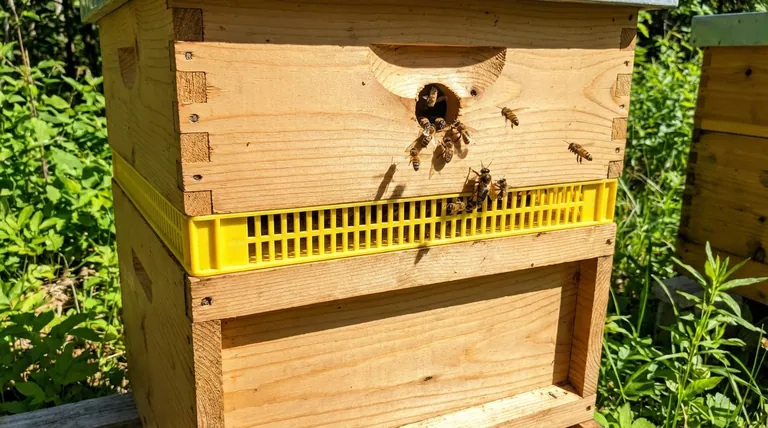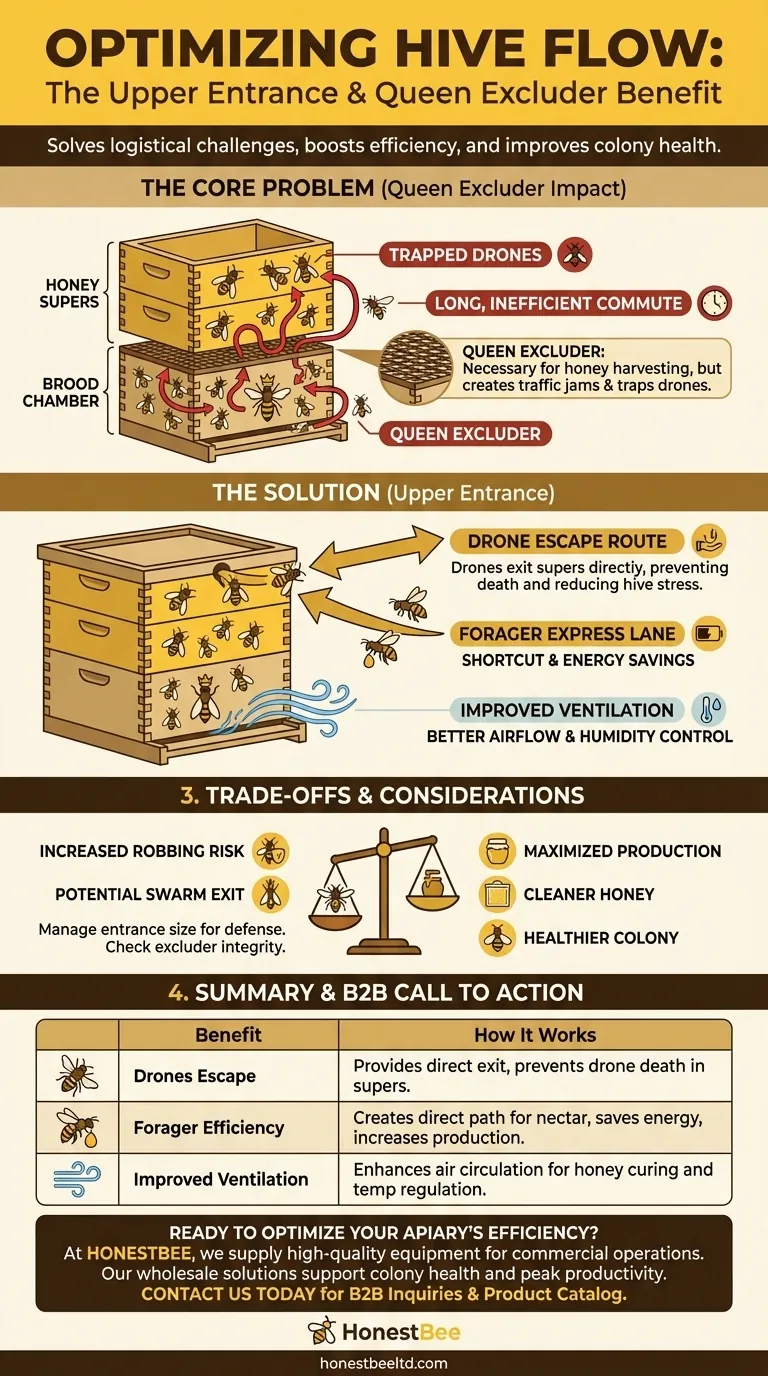Installing an upper entrance on a hive with a queen excluder provides two primary, immediate benefits. It gives male bees (drones) an escape route from the honey supers where they would otherwise be trapped, and it creates a highly efficient shortcut for forager bees, saving them energy and time when depositing nectar.
A queen excluder is a necessary tool for pure honey harvesting, but it creates logistical problems for the colony. An upper entrance is the simple, elegant solution to the traffic jams and trapped drones caused by the excluder, directly improving hive efficiency and health.

The Core Problem: A Queen Excluder's Impact on Hive Flow
A queen excluder is a simple grate that allows smaller worker bees to pass through but blocks the larger queen and drones. This is fundamental to modern beekeeping, but it creates two specific challenges that an upper entrance solves.
Its Purpose: Brood-Free Honey
Beekeepers use a queen excluder to confine the queen to the lower boxes of the hive, known as the brood chamber.
This ensures she only lays eggs there, keeping the upper boxes (the honey supers) free of brood (bee larvae). This makes honey harvesting cleaner and more efficient.
The Unintended Consequence for Drones
Drones are male bees whose primary function is to mate with a queen. They are born in the brood chamber but can move up into the honey supers.
Once a queen excluder is placed between the brood chamber and the honey supers, any drone in the upper boxes is trapped. They are too large to fit back through the excluder and will die in the supers, creating a cleanup problem for the worker bees.
The "Traffic Jam" for Foragers
Forager bees returning to the hive with nectar must deposit it in the honeycomb of the upper supers.
Without an upper entrance, a forager must enter the hive at the very bottom, navigate through the busy and crowded brood chamber, pass through the queen excluder, and then travel all the way up to the top boxes. This is a long and inefficient commute.
How an Upper Entrance Solves the Problem
Adding a small, secondary entrance to the top honey super is a simple modification that dramatically improves the hive's internal logistics.
Providing an Escape Hatch
An upper entrance gives trapped drones a direct exit from the honey supers. This prevents them from dying inside the hive, reducing stress and unnecessary work for the colony.
Creating an Express Lane for Honey
For forager bees, the upper entrance acts as a private driveway directly to the honey supers.
They can fly directly to the top of the hive, deposit their nectar, and leave, bypassing the congestion of the main entrance and brood nest entirely. This conserved energy can be redirected toward collecting more resources.
Improving Ventilation
A secondary benefit of an upper entrance is improved air circulation. This helps regulate temperature and humidity within the hive, which is crucial for both the bees' comfort and the process of curing nectar into honey.
Understanding the Trade-offs
While highly beneficial, an upper entrance is not without considerations. A beekeeper must manage the potential downsides.
Increased Risk of Robbing
Any additional entrance is a potential access point for robber bees from other hives, especially if the colony is weak. An upper entrance should be small enough that the colony's guard bees can easily defend it.
A Potential Swarm Exit
The queen excluder is meant to keep the queen in the brood chamber. However, if she were to get past it (due to a gap or damage), an upper entrance provides a convenient exit point for her to leave with a swarm.
Making the Right Choice for Your Hive
The decision to add an upper entrance should be based on the strength and goals of your colony.
- If your primary focus is maximizing honey production: An upper entrance is a critical tool for boosting forager efficiency and should be implemented as soon as you add honey supers.
- If your primary focus is colony health and cleanliness: An upper entrance is essential to prevent the problem of drones dying and decaying in your honey supers.
- If you are managing a new or weaker colony: You may want to keep the upper entrance closed or very small until the colony has the population to defend both entrances from robbers.
By understanding the hive's workflow, you can see that an upper entrance is a simple modification that directly solves the inefficiencies created by a queen excluder, leading to a more productive and healthy colony.
Summary Table:
| Benefit | How It Works |
|---|---|
| Drones Escape | Provides an exit for trapped drones, preventing them from dying in honey supers. |
| Forager Efficiency | Creates a direct path for nectar delivery, saving bee energy and increasing honey production. |
| Improved Ventilation | Enhances air circulation, aiding in honey curing and hive temperature regulation. |
Ready to optimize your apiary's efficiency and honey yield?
At HONESTBEE, we supply commercial apiaries and beekeeping equipment distributors with the high-quality supplies needed for peak performance. Our equipment, including solutions for hive modifications like upper entrances, is designed to support the health of your colonies and the productivity of your operation.
Let our wholesale-focused expertise help you build a more profitable and sustainable beekeeping business. Contact our team today to discuss your needs and explore our product catalog.
Visual Guide

Related Products
- Professional Plastic Queen Excluder for Modern Beekeeping
- Wooden Queen Bee Excluder for Beekeeping
- Premium Wood Framed Metal Wire Queen Bee Excluder
- Metal Queen Bee Excluder for Beekeeping
- High Performance Plastic Queen Excluder for Beekeeping and Apiary Management
People Also Ask
- How do queen excluders work in terms of spacing and bee movement? A Guide to Precision Hive Management
- What are the pros of using a queen excluder? Boost Hive Control & Honey Quality
- What are the pros of using queen excluders? Boost Honey Production & Hive Efficiency
- What is the primary function of a queen excluder in beekeeping? Control Hive Layout for Efficient Honey Harvesting
- What is the role of a queen excluder when adding a super? Ensure Brood-Free Honey Harvests



















